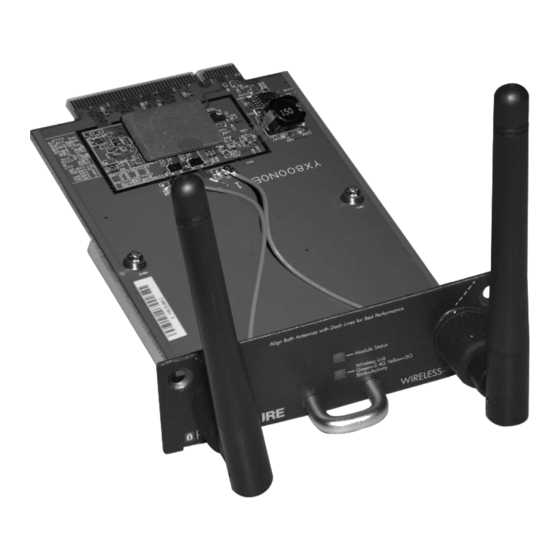
Advertisement
Quick Links
UTM9SWLSN_IG_28June11.fm Page 1 Tuesday, June 28, 2011 4:02 PM
ProSecure™ Unified Threat Management UTM9SWLSN Module
This guide describes how to install and remove the ProSecure Unified Threat
Management UTM9SWLSN Module. Refer to the UTM9S Reference Manual for
configuration instructions. You can access the Reference Manual from the UTM9S
product management interface, via the Resource CD, or from the NETGEAR
support site: http://support.netgear.com.
Verify the Package Contents
•
ProSecure™ UTM9SWLSN Module
•
Installation Guide
UTM9SWLSN
Install Module
Installation Guide
To install the module:
Note:
Only one wireless module can be installed. It can be installed in either
accessory slot.
1.
Turn off power to the UTM9S unit.
2.
Remove one of the blank plates on the UTM9s front panel.
3.
Save the cover plate for possible later use.
4.
Insert the module firmly into the UTM9S.
5.
Secure the module using the two panel screws.
6.
Restore power to the UTM9S.
Remove Module
To remove the module:
1.
Turn off power to the UTM9S unit.
2.
Remove two screws securing the module.
3.
Pull the module straight back from the UTM9S.
4.
If the module is replaced, follow the Install Module Procedure. If the module is
not replaced at this time, install a cover plate over the module slot.
5.
Restore power to the UTM9S.
Advertisement

Summary of Contents for NETGEAR ProSecure UTM9SWLSN
- Page 1 Management UTM9SWLSN Module. Refer to the UTM9S Reference Manual for configuration instructions. You can access the Reference Manual from the UTM9S Secure the module using the two panel screws. product management interface, via the Resource CD, or from the NETGEAR Restore power to the UTM9S. support site: http://support.netgear.com.
- Page 2 ©2011 by NETGEAR, Inc. All rights reserved. NETGEAR and the NETGEAR logo are registered trademarks of June 2011 NETGEAR, Inc. in the United States and/or other countries. Other brand and product names are trademarks or registered trademarks of their respective holders. Information is subject to change without notice.
- Page 3 Federal Communication Commission Interference Statement This device complies with Part 15 of the FCC Rules. Operation is subject to the following two conditions: (1) This device may not cause harmful interference, and (2) this device must accept any interference received, including interference that may cause undesired operation.
- Page 4 This device is intended only for OEM integrators under the following conditions: 1) The antenna must be installed such that 20 cm is maintained between the antenna and users, and 2) The transmitter module may not be co-located with any other transmitter or antenna.
- Page 5 Industry Canada statement This device complies with RSS-210 of the Industry Canada Rules. Operation is subject to the following two conditions: (1) This device may not cause harmful interference, and (2) this device must accept any interference received, including interference that may cause undesired operation. Ce dispositif est conforme à...
-
Page 6: Important Note
2) Le module émetteur peut ne pas être coïmplanté avec un autre émetteur ou antenne. 3) L'approbation du module est valable uniquement lorsque le module est installe dans l'equipement teste ou dans des equipements compatibles testes Tant que les 3 conditions ci-dessus sont remplies, des essais supplémentaires sur l'émetteur ne seront pas nécessaires. - Page 7 Manual Information To the End User The OEM integrator has to be aware not to provide information to the end user regarding how to install or remove this RF module in the user’s manual of the end product which integrates this module. The end user manual shall include all required regulatory information/warning as show in this manual.
- Page 8 antenna of a type and maximum (or lesser) gain approved for the transmitter by Industry Canada. To reduce potential radio interference to other users, the antenna type and its gain should be so chosen that the equivalent isotropically radiated power (e.i.r.p.) is not more than that necessary for successful communication.